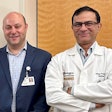
The vast majority of industry payments to radiation oncology researchers are concentrated among just 10 individuals, according to a study published September 12 in the Journal of the American College of Radiology. And researchers who received payments from industry were more likely to publish more papers.
Industry payments to physicians and healthcare researchers have generated concerns for years due to potential conflicts of interest. The passage in the U.S. of the Physician Payments Sunshine Act mandated that industry payments be reported to a database that's open to the public to make industry-physician relationships more transparent.
Previous studies have suggested that radiation oncologists are less forthcoming than colleagues in surgery and medical oncology in reporting industry ties, according to a multicenter research team led by Dr. Nicholas Zaorsky of Penn State Cancer Institute. So Zaorsky and colleagues decided to explore financial links with radiation oncologists by analyzing the Open Payments database maintained by the U.S. Centers for Medicare and Medicaid Services (CMS) (JACR, September 12, 2018).
The group focused on radiation oncologists listed in the Open Payments database in 2015; the database includes payments of at least $10 made to physicians by companies. The researchers further categorized radiation oncologists as "academic" or "nonacademic" to see if payments varied by practice setting. Industry payments were also characterized by type, such as general payments, research-related contributions, or ownership and investment payments.
They then calculated each researcher's productivity using an h-index, defined as the number of publications (h) that have been cited at least h times apiece -- for example, a researcher with an h-index of at least 10 had published 10 papers that were each cited at least 10 times in the literature. Another measure, m-index, indicated how quickly the h-index had risen, or how rapidly the research had risen in seniority.
The researchers found a total of $25.5 million in payments made to 2,995 individual radiation oncologists, but the payments were far from evenly distributed. In fact, just 561 academic radiation oncologists received $12.6 million (56%) of all payments made. What's more, just 10 individuals received $6.4 million in payments.
When it came to publication productivity, Zaorsky and colleagues found that general payments were associated with more papers published, as measured by h-index and m-index.
The authors cautioned that industry involvement in research can have both positive and negative results. But the findings raise the specter of financial conflict if industry funding is driving the results of research, and the conclusions of some studies could be inaccurate.
"A partnership between academia and industry may lead to scientific discoveries," they wrote. "In contrast, industry-funded trials are more likely to publish positive results, and clinicians as well as patients may question the integrity of the conclusions."



















